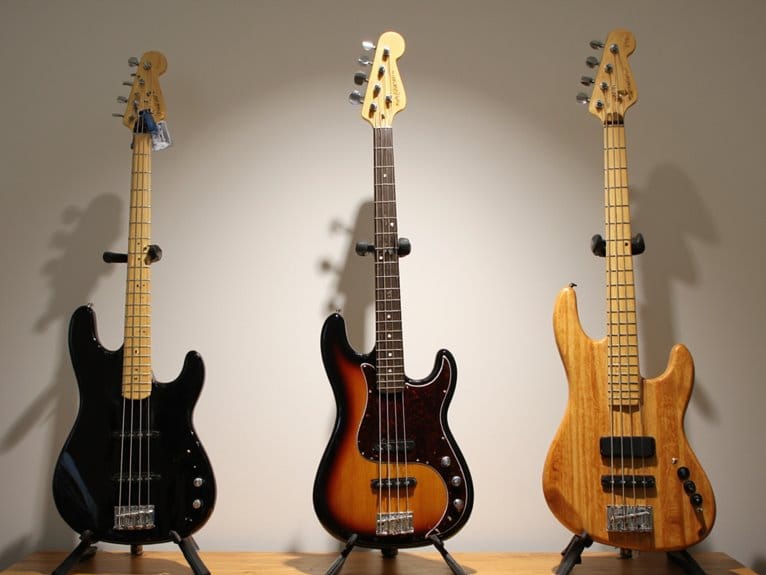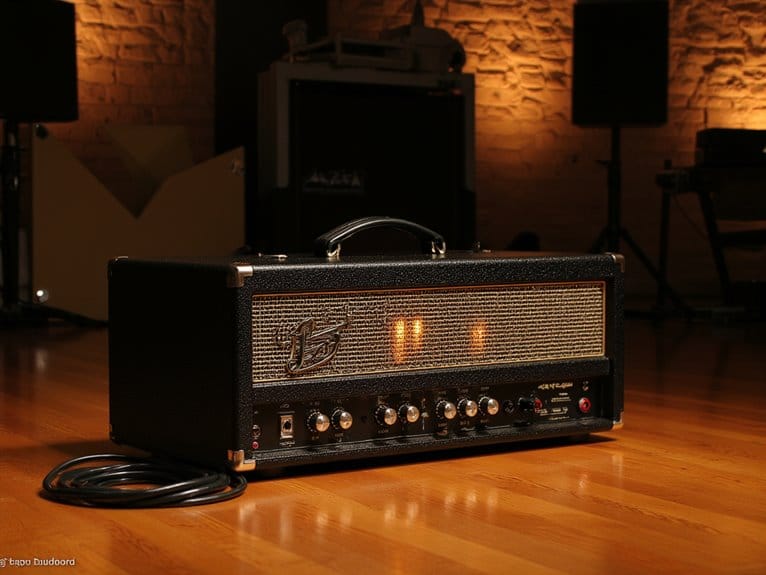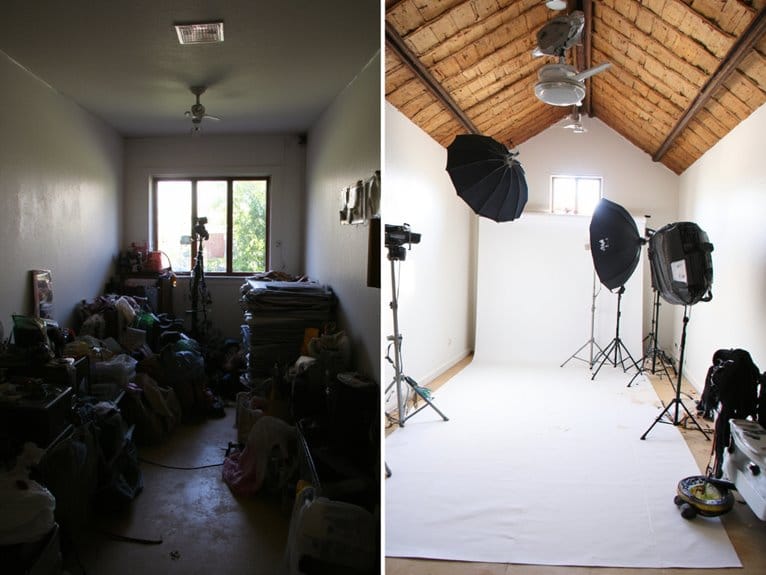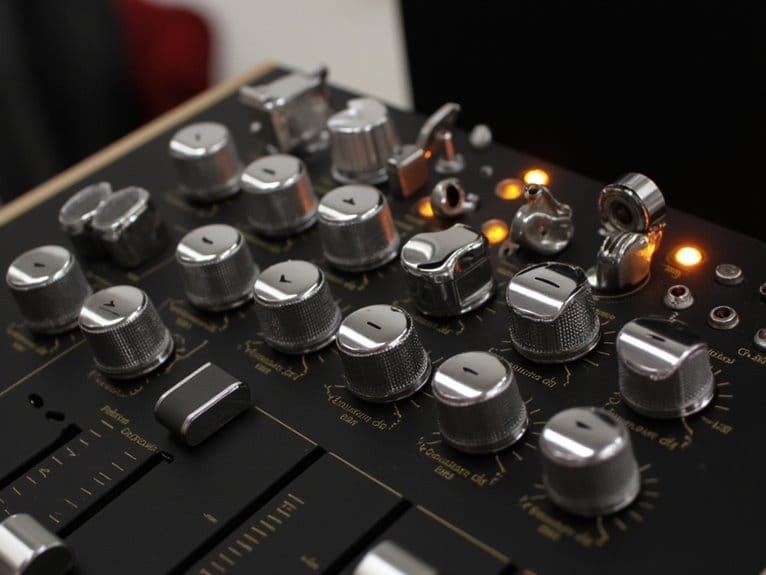Budget Bass Selection: Getting the Best Value for Your Money
When you’re hunting for budget bass value, I’d recommend focusing on brands like Sterling SUB Ray4, Squier Affinity PJ Bass, and Yamaha TRBX series, which deliver authentic tones without breaking your bank account. You’ll want dual-pickup configurations for blending capabilities, proper weight balance to prevent shoulder strain, and alder body construction that offers both warmth and durability. Smart buyers should prioritize playability factors like neck profile and string action over flashy aesthetics, since these directly impact your long-term satisfaction and playing comfort. Additionally, investing in a quality compression pedal for bass can further enhance your sound by ensuring a more consistent tone and dynamic response, especially in live performances. Consider pairing your budget-friendly bass with a versatile amplifier that complements its tonal character, allowing you to explore a range of musical styles. Lastly, don’t overlook the importance of regular maintenance and setup adjustments to keep your instrument in top playing condition.
We are supported by our audience. When you purchase through links on our site, we may earn an affiliate commission, at no extra cost for you. Learn more.
Notable Insights
- Consider dual-pickup configurations like Squier Affinity PJ Bass for tonal versatility and blending capabilities over single-pickup models.
- Prioritize alder body construction for optimal balance of warmth, durability, and sound quality at budget price points.
- Test neck profiles and fretboard radius to ensure comfort during extended playing sessions and reduce hand fatigue.
- Look for brands like Yamaha TRBX and Sterling SUB Ray4 that offer reliable hardware and authentic tones.
- Budget for potential electronics upgrades as quality components significantly improve sound performance and long-term value.
Top Budget Bass Brands and Models Worth Considering
When I first started hunting for quality bass guitars without emptying my wallet, I discovered that five standout brands consistently deliver exceptional value in the budget category, each offering distinct tonal characteristics and build qualities that punch well above their price points.
Sterling models like the SUB Ray4 emulate classic StingRay tones with active electronics, while Squier designs such as the Affinity Precision PJ Bass provide authentic Fender sound at beginner-friendly prices.
Sterling’s SUB Ray4 delivers authentic StingRay punch through active electronics, while Squier’s Affinity PJ Bass captures classic Fender warmth at entry-level pricing.
Yamaha versatility shines through the TRBX series with reliable build quality, and Ibanez craftsmanship delivers lightweight basses with slim necks perfect for technical playing. The Tansen EB100 offers high quality at an affordable price point, making it an excellent entry-level option.
Finally, Epiphone tones from the Thunderbird and Gretsch aesthetics in the Junior Jet II offer vintage-inspired character without breaking your budget. The Sterling by Music Man SUB Ray 4 stands out as an affordable option that works perfectly for home studios or as a reliable backup for live gigs. For rock players specifically, consider basses with dual humbucking pickups that provide the aggressive tonal versatility and noise rejection essential for heavier music genres. Understanding pickup configurations helps determine which bass will best suit your preferred musical genres and playing style.
Essential Features That Impact Value and Performance
While brand names often capture our attention first, I’ve learned that understanding specific features makes the difference between a bass that’ll serve you well for years and one that’ll leave you frustrated within months.
Pickup variety greatly impacts your tonal options, with dual-pickup configurations offering essential blending capabilities that single-pickup models can’t match. Weight balance affects your comfort during extended playing sessions, making properly distributed instruments far more valuable than lighter basses with poor balance points. Budget options provide an excellent opportunity to explore different styles without financial risk, especially for beginners who are still discovering their musical preferences.
Scale length considerations become particularly important for comfort, as short scale models allow easier reach to bottom frets and prove especially beneficial for beginners learning proper technique.
| Feature Category | Budget Option | Impact on Performance |
|---|---|---|
| Neck Construction | Bolt-on | Easier repairs, good sustain |
| Electronics | Passive pickups | Warm tone, no battery dependency |
| Hardware | Die-cast tuners | Adequate stability for beginners |
| Finish | Polyurethane | Durable protection, slight weight increase |
Sound Quality and Tonal Characteristics in Affordable Basses
Nothing matters more than understanding how your bass will actually sound before you commit your hard-earned money, and I’ve discovered that several key factors determine whether a budget instrument delivers satisfying tones or leaves you questioning your purchase.
Different pickup types dramatically shape your sound, with single-coils offering bright clarity but potential hum, while humbuckers provide fuller, quieter tones perfect for versatile playing. I’ve found that split-coil designs balance punch and clarity effectively in affordable Precision-style basses.
Wood combinations matter too, as alder bodies deliver balanced warmth and brightness, while mahogany emphasizes midrange richness. Modern budget basses often include active EQ systems that allow you to adjust frequency response and refine your tone beyond what passive electronics can achieve. Some innovative models feature PowerSpan pickups that can operate as either single coils or humbuckers, giving you maximum tonal flexibility from a single instrument.
Though budget instruments won’t replicate high-end tonal nuances perfectly, quality examples achieve surprisingly pleasing, usable sounds that’ll satisfy most players’ needs.
Playability Factors That Matter for Long-Term Satisfaction
The bass that feels perfect in the music store might become your worst enemy during a two-hour practice session, and I’ve learned that comfort factors often determine whether you’ll reach for your instrument daily or let it collect dust in the corner.
Your neck profile considerably impacts hand fatigue, with slimmer C-shapes favoring speed while thicker profiles support fingerstyle stability. The fretboard radius affects bending ease and chord comfort, so test different curvatures against your playing style.
Proper string action prevents buzzing while maintaining playability, though you’ll likely need a professional setup initially. Weight balance matters more than total weight, preventing neck dive and shoulder strain.
Look for playability enhancers like rounded fret edges, smooth finishes, and ergonomic features such as cutaways for upper fret access. Modern manufacturers are increasingly incorporating lightweight designs to reduce player fatigue and improve overall comfort during extended playing sessions. This growing focus on comfort reflects the market’s response to increased demand for high-quality instruments that support both professional musicians and the rapidly expanding amateur segment.
Hardware Reliability and Market Trends for Smart Buyers
When you’re hunting for a budget bass that won’t leave you stranded mid-song, I’ve discovered that hardware reliability often separates instruments you’ll cherish for decades from those destined for Craigslist after six months of frustration.
Hardware reliability separates cherished instruments from frustrating purchases destined for quick resale after months of disappointment.
You’ll want to focus on tuning machines from brands like Hipshot or Grover, which use superior hardware materials that resist corrosion and maintain precision over time.
Active systems present longevity concerns since battery failures can silence your bass instantly, though dual-battery configurations improve reliability considerably.
I’ve noticed that Fender Player Series models strike an excellent balance between affordability and dependable components, while the current trend toward lightweight designs sometimes compromises durability if manufacturers cut corners on metal quality to reduce weight. The alder body construction in many budget-friendly options provides both warmth and structural integrity that withstands regular use. Quality electronics at near wholesale prices from suppliers like Guitar Parts Depot can help you upgrade budget bass components without breaking your bank account.
On a final note
You’ve got the knowledge now to make smart bass choices without breaking your bank account. Remember, you’re investing in an instrument that’ll grow with your skills, so prioritize playability and reliable hardware over flashy aesthetics. I’ve seen countless players discover their signature sound on budget instruments that punch well above their price point. Trust your hands and ears – they’ll guide you to the bass that’s truly worth your hard-earned money.







